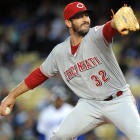
The Reds are halfway to fielding a competitive team, and here's what they need to return to relevancy in 2019
The Reds have to find some new starters -- and soon -- to maximize their competitive desires
The Cincinnati Reds will finish below .500 and outside of the playoff picture for a fifth consecutive season. Yet unlike in years past, this version of the Reds provides some hope.
Silly as it may sound, the Reds are halfway to fielding a competitive team. According to FanGraphs' catch-all offensive stat of choice (wRC+), the Reds have the 12th-best offense in baseball, tied with the Atlanta Braves and ahead of the St. Louis Cardinals and Milwaukee Brewers -- or, potentially, more than half the National League playoff field. With one exception (Scooter Gennett), all the Reds' most productive hitters -- Eugenio Suarez, Joey Votto, Jesse Winker, Scott Schebler, and Jose Peraza -- are under contract through at least the 2022 season. Add in top prospects Nick Senzel, Taylor Trammell, and Jonathan India, selected fifth in this year's draft, as well as a handful of others who are a few tiers down, and the Reds have hitters.
What the Reds need, then, is pitchers -- specifically starters.
The Reds have the fourth-worst rotation ERA in baseball, worse even than the messes put forth by the Chicago White Sox and Kansas City Royals. Put another way, the Reds have started nine pitchers at least three times this season -- one of them has an ERA+ better than 90 (Matt Harvey, naturally), and just three others have an ERA south of 5.00.
Theoretically, the Reds could justify entering next season with three of their current starters: Anthony DeSclafani, Luis Castillo, and Tyler Mahle. Say the Reds retain Harvey, who is set to qualify for free agency. That would enable them to give the fifth spot to Cody Reed or some other young arm who merits a look. The problem with that is -- well, the Reds don't have much in terms of promising pitching prospects. There's Hunter Greene, the former No. 2 pick in the draft … but he's a teenager trying to get his sea legs in A-ball. Otherwise, just two Reds pitching prospects are average or better per MLB.com: Tony Santillan and Vladimir Gutierrez.
Sure, maybe someone reading is higher on Josiah Gray, or thinks that Sal Romano and/or Brandon Finnegan and/or whomever deserves another shot at making it big. But it probably wouldn't hurt the Reds to at least consider turning some of their hitting surplus into an arm. Heck, they could make their team more balanced and better by simply trading Gennett, who will qualify for free agency next winter, and who has a near ready-made heir in Senzel.
The biggest hurdle there is that the free-agent market is loaded with second basemen: Daniel Murphy, Brian Dozier, Ian Kinsler, Jed Lowrie, and DJ LeMahieu, among others. The other hurdles include the Reds' desire to manipulate Senzel's service time, and finding a willing partner. Would the Washington Nationals take Gennett for Tanner Roark? What about the Los Angeles Dodgers and Alex Wood? The Los Angeles Angels and Tyler Skaggs? Who knows.
The Reds don't have to trade Gennett, and even if they do move him they might prefer to get a prospect package in return. Still, if they want to get serious about fielding a competitive team -- and avoiding a sixth consecutive losing season -- then trading some of their hitters, either veterans or prospects, for some arms is a scenario worth considering.


















